Repairing Wrought Iron Furniture: A Comprehensive Guide
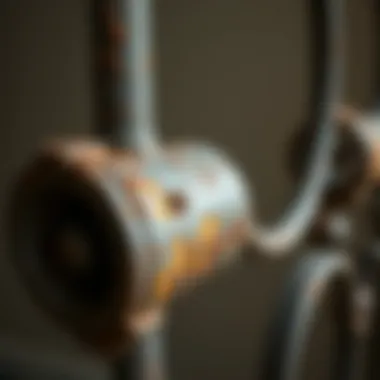
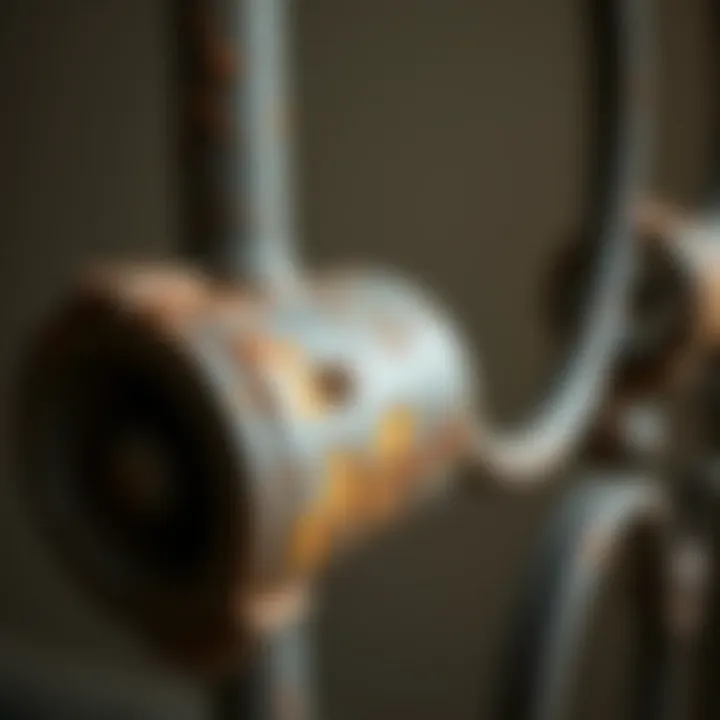
Intro
Wrought iron furniture has an elegance that seems to transcend time. Whether it’s a quaint garden bench or an ornate dining table, these pieces can add character to any setting. However, the charm of wrought iron can fade over years due to wear and tear, but fear not! Restoring them is an attainable feat for both seasoned DIYers and those dabbling in home improvement.
This guide dives into the nuances of repairing and revitalizing wrought iron items, shedding light on common issues like rust and structural flaws. With the right techniques, tools, and a dash of creativity, these once-forgotten treasures can shine brighter than a new pin.
Let’s roll up our sleeves and get to it—restoration is not just about aesthetics but breathing new life into furniture that often holds stories of the past.
Design Inspiration
Wrought iron’s versatility is one of its greatest strengths. It can effortlessly blend into various design styles, lending its robust character to both indoor and outdoor settings. Let's explore how to infuse fresh inspiration into your repurposing journey.
Trending Styles and Themes
There are a multitude of styles one can achieve with wrought iron. Some popular trends include:
- Industrial Chic: Think of raw, unpolished surfaces paired with matte black finishes. This style captures a rustic yet modern aesthetic, allowing wrought iron’s strong lines to take center stage.
- Vintage Romance: Soft curves and intricate designs can enhance the vintage feel. Adding pastel colors or floral motifs can coax the charm out of any older piece.
- Minimalist Approach: In a world leaning towards minimalism, a simple wrought iron frame can make a statement without being overwhelming. Less is truly sometimes more.
Color Palettes and Combinations
Choosing the right colors can amplify the iron’s beauty. Popular combinations include:
- Classic Black and White: This timeless duo is suited for any setting, making pieces look sleek and refined.
- Earthy Tones: Colors like olive green, rust orange, or deep browns can complement natural surroundings, making these pieces perfect for outdoor settings.
- Bold Accent Colors: A coat of bright blue or sunny yellow can rejuvenate wrought iron while making it a conversation starter in any space.
Take inspiration from your surroundings and personal preferences, and don’t shy away from mixing and matching. After all, the goal of restoration is not merely to fix but to enhance and adapt to today’s aesthetic desires.
Tools and Materials Needed
To achieve a successful restoration, a selection of tools is necessary:
- Wire Brush and Sandpaper: Essential for removing rust and old paint.
- Rust Inhibitor: Helps protect your iron furniture from future rust issues.
- Paint or Finish: Depending on the look you want, either an enamel spray for a glossy finish or a matte paint can suffice.
Utilizing the right materials is vital. Opt for non-toxic paints and finishes that ensure durability without sacrificing your health or the environment.
Ending
The restoration of wrought iron furniture offers not just a project to engage in, but a profound way to reclaim and rejuvenate artistry that may have been lost. By following a few simple guidelines and letting personal creativity blossom, it is possible to breathe new life into these beautiful pieces, making them not just objects of use, but pieces of history that tell their own story. With this guide, you're well on your way to transforming those weary relics into stunning focal points of your home.
Prelims to Wrought Iron Furniture
Wrought iron furniture has long captured the hearts of homeowners and designers alike. This unique material is not just about aesthetics; it carries with it a rich tapestry of history and an array of benefits that make it a resilient choice for both indoor and outdoor use. Understanding wrought iron furniture is essential for anyone looking to incorporate charm and durability into their spaces.
Historical Significance
The legacy of wrought iron furniture dates back centuries, solidified during the medieval era when artisans began forging iron into intricate designs. This technique provided not only strength but also an avenue for personal expression within the pieces being crafted. Statues, gates, and, eventually, furniture emerged in various styles, lighting up the age with their functional beauty.
Over the years, wrought iron became synonymous with elegance. The intricate scrollwork and curved designs signified both luxury and durability, making them popular in courtyards and parlors worldwide. These pieces have adorned homes from the Spanish Colonial period to Victorian estates, grounding them firmly in historical relevance. Today, this timeless appeal has translated into modern design, ensuring that wrought iron remains relevant in contemporary homes.
Common Applications
When it comes to applications, wrought iron furniture shines across various settings. Its robust nature makes it suitable for:
- Outdoor Spaces: Wrought iron garden benches, tables, and chairs withstand the elements, while their ornate designs add a touch of sophistication to any patio.
- Indoor Decor: From stylish coffee tables to ornate bed frames, wrought iron complements a variety of interior design styles, from rustic to industrial.
- Commercial Establishments: Restaurants and cafes often choose wrought iron furniture for its durability and ease of maintenance, coupled with timeless design that enhances customer experience.
By recognizing these common applications, one can appreciate the versatility of wrought iron, making it an ideal choice for affordability, practical usage, and enhanced design.
Common Issues with Wrought Iron Furniture
Wrought iron furniture is admired for its elegance and durability, but it isn’t immune to wear and tear over time. Addressing common issues not only preserves the beauty and functionality of these pieces but also extends their lifespan. Homeowners, interior design enthusiasts, and gardeners alike will want to understand these challenges, as they can impact the aesthetic and structural integrity of the furniture. From rust development to structural weaknesses and peeling paint, each problem presents its own set of concerns that require attention.
Rust Development
One of the most prevalent issues faced by wrought iron furniture is rust development. This occurs when the protective coatings break down, exposing the metal to moisture and air. Iron is particularly susceptible to oxidation, making rust a common sight on outdoor pieces left exposed to the elements.
Rust not only tarnishes the appearance of furniture but can also compromise its structural integrity. A chair that looks stylish but hides rust beneath the surface may not be safe for use. Therefore, understanding how to spot and tackle rust early is crucial. Effective rust prevention can be achieved through a few methods:
- Regular Cleaning: Removing dirt and moisture prevents rust from taking hold.
- Protective Coatings: Applying a rust-resistant paint or sealant can greatly reduce the chances of rust formation.
- Storage Solutions: Keeping furniture indoors during wet seasons can shield it from moisture.
"A stitch in time saves nine." – This adage rings especially true when dealing with rust. Address it promptly before it escalates.
Structural Weakness
Structural weaknesses, whether from excessive wear, poor initial construction, or damage from impacts, can make wrought iron furniture dangerous and unsightly. The most common areas of concern usually include joints and welds, which can degrade over time or become stressed under pressure.
- Identifying Weak Points: Regularly check for visible signs of weakness, such as cracking or bending, particularly in sections where two pieces are joined.
- Reinforcing Techniques: If structural damage occurs, reinforcing joints through welding or bracing will help restore strength. Knowing when to intervene can save your favorite pieces from becoming unusable.
- Prevention Measures: Ensure that weight limits are respected and avoid placing excess strain on weaker areas.
Addressing structural weaknesses early on is vital. If left unattended, these issues can lead to more severe problems down the line, including complete loss of functionality.
Peeling Paint
Aesthetically, peeling paint can be a significant drawback for wrought iron furniture. This problem usually arises from weather exposure, but it can also be a result of improper application of paint or use of low-quality products. The beauty of wrought iron is often highlighted through its finishing, so keeping it in top shape is vital for visual appeal.
- Understanding Causes: Peeling paint can happen when moisture gets trapped beneath the surface or when the paint has not adhered well to the metal.
- Repairing Techniques: Strip the peeling areas back to the bare metal, treat any rust underneath, and then reapply a high-quality primer and paint.
- Maintenance Tips: Frequent touch-ups can prevent extensive peeling and keep the furniture looking fresh.
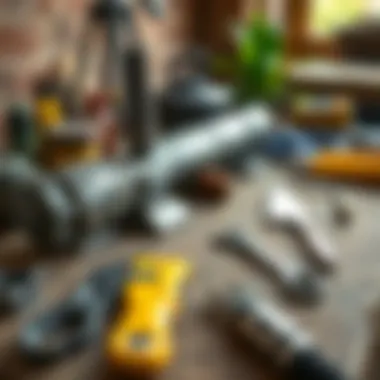
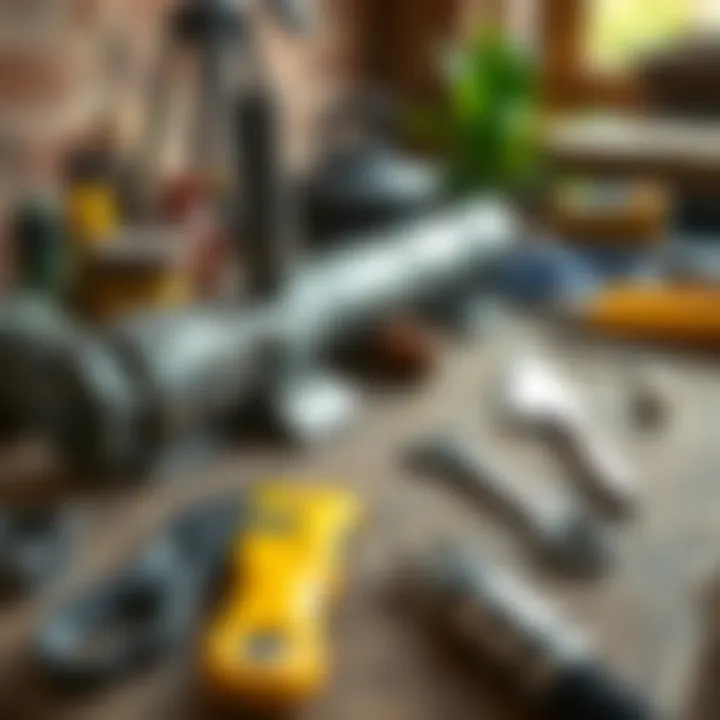
Regular maintenance and a keen eye for these common issues will keep your wrought iron furniture both functional and visually stunning. By understanding and addressing rust, structural weaknesses, and peeling paint, owners can ensure the longevity of these cherished pieces, creating a lasting impact in their living spaces.
Essential Tools for Repairing Wrought Iron Furniture
Repairing wrought iron furniture isn’t just about elbow grease and patience; having the right tools is critical. The success of your project largely hinges on your equipment. The right tools not only make the job easier but ensure that repairs last and the finished product looks appealing. Whether you're a seasoned DIYer or a newcomer, understanding the importance of essential tools can save time, money, and frustration down the line.
Basic Tools
Screwdrivers
Screwdrivers play an indispensable role in any repair job. For wrought iron furniture, they assist in disassembling components before a thorough inspection. The key characteristic of screwdrivers lies in their variety; flathead and Phillips head types can address different screw designs. A popular choice among DIY enthusiasts, their adaptability simplifies the repair process. Moreover, a set of screwdrivers can help reach tight spaces that may be otherwise inaccessible. The disadvantage, however, comes when the screw heads are stripped, which can complicate the process.
Wrenches
Wrenches are particularly crucial when dealing with the bolts that hold wrought iron pieces together. Their main attribute is the ability to provide extra torque, which assists in loosening or tightening bolts securely. This tool is vital for structural integrity, ensuring that connections are sound after repairs are made. A common choice for many enthusiasts due to their versatility and ease of use, the downside is that a fixed wrench may not fit all bolt sizes, limiting its effectiveness in some situations.
Hammers
The hammer's role in repairing wrought iron furniture shouldn't be underestimated. It’s often employed to gently realign bent metal parts, allowing for precise adjustments. The key feature of hammers is their ability to deliver force at various angles, allowing for both delicate and heavy-handed applications. They are valued in the DIY community for their simplicity and inexpensive nature. However, misuse of a hammer can lead to further damage if not handled properly, as every strike needs precision and care.
Protection Gear
Gloves
Gloves are more than just an accessory during repairs; they serve a practical purpose. Leather or heavy-duty work gloves protect the hands from sharp edges and rust. This essential protection allows for focused work without the nagging worry of cuts or scrapes. A beneficial choice for those engaged in repair work, gloves offer ample grip, ensuring tools don't slip, which adds a layer of safety. However, they can limit dexterity, especially with fine tasks, requiring practice to find the right balance.
Safety Goggles
Eye protection is of utmost significance. When cleaning or working on wrought iron, debris can often fly, posing a risk to your eyes. Safety goggles are specifically designed to prevent this. Their critical feature is the durable lens that shields your eyes from particles and even harmful chemicals. They are a popular choice among DIY aficionados because they allow for visibility without compromising safety. On the downside, they may feel bulky to some, but the importance of protecting one's sight far outweighs any discomfort.
Cleaning Supplies
Wire Brushes
Wire brushes are a staple for cleaning rust from wrought iron furniture. Their stiff bristles make short work of loose rust and paint, prepping the metal for further restoration. A key characteristic is their ability to reach into crevices where traditional brushes fail. This makes them a beneficial choice in restoring the piece’s underlying structure. However, using them too aggressively can scratch the surface, so it’s crucial to handle with care to avoid further damage.
Sandpaper
Sandpaper complements wire brushes effectively. It smooths the surface after the rough cleaning has been done, giving the furniture a polished look before repainting. A notable benefit of sandpaper is its range of grits, from coarse for stripping paint to fine for finishing touches. However, overzealous sanding can wear down the metal, so it is important to select the right grit and use it judiciously.
Preparing for the Repair Process
Before diving into the restoration of wrought iron furniture, taking a step back to prepare is crucial. The importance of this preparatory stage cannot be overstated as it lays the foundation for all subsequent efforts. Proper preparation ensures not only a smoother repair process but also significantly enhances the chances of successful outcomes. By conducting an initial evaluation and gathering necessary tools and materials, homeowners and DIY enthusiasts can tackle restoration tasks with confidence and efficiency.
Initial Assessment
The first step in preparing for your repair journey is conducting a thorough initial assessment. This involves a careful examination of the item. What you’re looking for are signs of rust, structural setbacks, or any aesthetic degradation such as fading paint.
- Documentation: Take photos from various angles. It can help to refer back to these images as you make progress.
- Identifying Problems: Make a list of issues observed. For instance, is the seat secure? Are there patches of rust forming that command attention?
- Research: Dive into the specifics of the piece, if possible. Knowing its history adds depth to your restoration efforts. Various resources may shed light on similar pieces and aids in comparison.
By pinpointing areas needing work, you can effectively prioritize tasks. Often, the most alarming issues are the most apparent, yet it pays to look deeper. Smaller problems can sometimes morph into larger hurdles if left unchecked.
Removing Loose Parts
Once the initial assessment is complete, it’s time to get your hands dirty by removing loose parts. This is an essential part of preparing for a thorough repair. Loose components can often complicate the restoration process and create setbacks if not dealt with ahead of time.
- Tools Needed: Have your screwdrivers, wrenches, and hammers at the ready. Depending on your piece, you may require specific tools unique to the hardware.
- Systematic Removal: Start by detaching any loose pieces carefully. For instance, if there are removable cushions or seating pads, take those off first. You don’t want to inadvertently damage these while you’re working on the iron.
- Labeling: As you remove parts, consider labeling them. This practice can save time and trouble later on when you’re ready to reassemble the entire structure. A simple numbered system might prevent confusion.
- Storage: Keep removed parts in a safe place, ideally organized clearly. Small containers can be beneficial to safeguard screws and other bits.
By handling loose parts at this stage, you ensure that the structure remains stable throughout the repair process. It also allows you to scrutinize each component, identifying any further concerns that were not visible when the item was fully intact.
In summary, preparing for the repair process encapsulates gathering insights through initial assessments and meticulous handling of loose elements. Skipping this phase can lead to unnecessary complications, but taking the time upfront can smooth the path ahead. This is the cornerstone of effective restoration and sets the scene for the work that lies ahead.
Addressing Rust Issues
Rusting poses a serious threat to wrought iron furniture, which can quickly turn a beautifully crafted piece into a shadow of its former self. Addressing rust not only preserves the integrity of the furniture but also maintains its aesthetic appeal. Recognizing the beginnings of rust and taking prompt action can extend the lifespan of furniture significantly. There are several techniques to remove existing rust and crucial methods to prevent future issues.
Rust Removal Techniques
Chemical Rust Removers
Chemical rust removers have gained popularity in recent years due to their effectiveness. These products typically contain compounds that react with rust to dissolve it, making the job considerably easier. One of the key characteristics of chemical rust removers is their quick action. Often, you just apply the solution, let it sit for a specified time, and scrub away the rust.
Its primary benefits include saving time and often requiring less elbow grease compared to manual methods. However, it’s worth noting these products can sometimes be harsh. The unique feature of chemical rust removers is their ability to penetrate deeply into rusted areas, which can be a major advantage when dealing with intricate designs of wrought iron.
Nevertheless, be cautious. Always use gloves and ensure good ventilation when working with harsh chemicals, as they can emit harmful fumes. On the other hand, they can be a lifesaver in restoring heavily rusted items, giving them a fresh start.
DIY Vinegar Solutions
If you’re seeking a more natural approach or perhaps a budget-friendly option, DIY vinegar solutions can be a fantastic choice. Vinegar, particularly white vinegar, is well-known for its rust-removing properties. The acid in vinegar reacts with the oxidization of the metal, loosening the rust for easy removal.
The characteristic of DIY vinegar solutions that appeals to many is that they are non-toxic, making them safer for home use than many commercial products. Pouring vinegar over the affected areas and letting it soak typically does the trick—but time and patience are key.
One unique feature here is that vinegar is often on hand in most kitchens, so there’s no need to make a special trip to the store. However, while effective on light rust spots, it may require repeated applications for heavier rust, adding to the time commitment. Despite this, the method exemplifies resourcefulness and aligns well with the growing trend of using sustainable practices in home care.
Preventing Future Rust
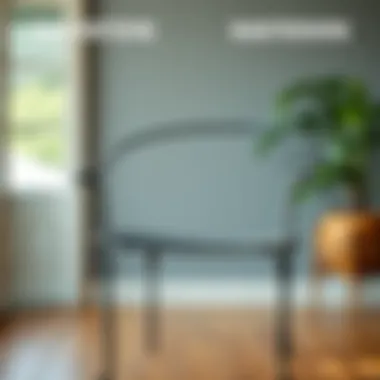

Once you’ve successfully addressed rust issues, it’s crucial to take steps to prevent them from returning. Prevention plays a vital role in the longevity and visual quality of wrought iron furniture.
Rust Inhibitors
Rust inhibitors, often designed for use on metal surfaces, can form a protective barrier against moisture and other elements that contribute to rusting. These products work by chemically altering the surface of the metal, effectively blocking any reaction that would lead to rust development.
The key characteristic of rust inhibitors is their long-lasting effect. Often, one application can protect your wrought iron furniture for months, making it a wise choice for anyone looking to safeguard their investment. The unique aspect of rust inhibitors is their versatility; they can be applied alongside paint, offering dual protection.
However, it’s important to remember that regular maintenance is still key. While rust inhibitors significantly reduce the chances of rust formation, they should not be seen as a one-size-fits-all solution.
Protective Coatings
In addition to rust inhibitors, applying protective coatings serves as another effective method of preventing future rust. These coatings can include paints and varnishes that provide a physical barrier against the elements. The beauty of protective coatings lies in their aesthetic appeal, as they can be selected to enhance the overall look of the furniture.
A distinguishing feature is their durability; many modern coatings are designed to withstand various weather conditions. This means that wrought iron furniture that is used outdoors can enjoy protection from rain, snow, and UV rays. However, the challenge can lie in ensuring the surface is adequately prepared before application, as any existing rust or dirt can compromise the coating's adherence.
Repairing Structural Damage
Repairing structural damage in wrought iron furniture is a critical step in the restoration process. Unlike other materials, wrought iron is prized for its strength and durability, and when it sustains damage, it often needs careful attention to maintain its integrity. Addressing structural issues not only ensures the longevity of the furniture but enhances its overall safety and usability. Much like fixing a leak in a roof, ignoring these problems can lead to larger issues, so it’s vital to tackle them head-on.
Identifying Weak Points
To properly repair wrought iron furniture, the first step involves a thorough inspection to identify weak points. Look for bends, cracks, or areas where the metal has fatigued over time. A visual examination is a great start, but running your hands along the surfaces might also help you to feel any irregularities that the eye may miss. Certain indicators can alert you:
- Cracks: Small cracks that may be starting can be a sign of deeper structural issues.
- Bends or Warps: These are often a result of heavy loads or improper storage conditions.
- Rust Pockets: These can indicate where the metal has weakened, as rust eats away at the iron itself.
Taking note of these weaknesses is essential. It sets the stage for effective repairs. Remember, a stitch in time saves nine; fixing a small problem today can keep you from dealing with major repairs down the road.
Reinforcing Joints
Reinforcing the joints of wrought iron furniture is crucial for restoring strength and stability. Joints are often the most vulnerable parts, especially with age or if the piece has seen heavy use. Strengthening these connections can be approached through various methods, two of which are popular among restorers: welding techniques and bracing methods.
Welding Techniques
Welding is often regarded as the gold standard for reinforcing joints. This method involves melting base metals together to form a strong bond. The key characteristic of welding is its ability to restore the piece's original strength, making it as solid as a rock. Moreover, it allows for precision in aligning the metal, which is important when restoring the piece's aesthetic appeal.
One unique feature of welding is that it can be done using various techniques, such as MIG (Metal Inert Gas) or TIG (Tungsten Inert Gas) welding. Each of these has its advantages and disadvantages:
- MIG Welding: Faster and easier to learn, suitable for thicker metals.
- TIG Welding: Offers high-quality, precise welds but requires more skill and can be time-consuming.
In this article, welding is a beneficial choice due to its effectiveness in creating strong, lasting repairs, though it does require access to proper equipment. If you have the know-how or can enlist the help of a more experienced friend, this method pays off big time.
Bracing Methods
Bracing methods, on the other hand, serve to support compromised structural elements without the need for welding. These techniques involve adding extra materials—like plates or rods—that transfer weight and stress to reinforce weakened areas. The key characteristic of bracing is its simplicity and versatility. It can be a great option if welding isn’t viable or if you wish to make repairs without altering the original design too much.
Unique features of bracing methods include:
- Ease of Application: You can often perform these repairs without specialized welding skills.
- Temporary vs. Permanent: Bracing can be a temporary fix while you consider more permanent solutions, or it might serve as a long-lasting fix itself.
However, some disadvantages exist, like adding aesthetic bulk or compromising the visual lines of the furniture. It’s wise to consider both the practical and aesthetic outcomes of using these methods as you decide the right path for your piece.
Repainting Wrought Iron Furniture
Repainting wrought iron furniture serves as a crucial step in the restoration process, breathing new life into pieces that may have seen better days. Not only does a fresh coat of paint enhance the aesthetic appeal of aged furniture, but it also adds a layer of protection against rust and environmental wear. An effective repainting job can truly transform a forgotten item into a stunning focal point in any space, whether it's a quaint garden chair or an elaborate patio set. With a little effort, the transformation can be both economical and satisfying, reflecting personal style in every stroke.
Choosing the Right Paint
Choosing the right paint is fundamental to achieving a durable and visually pleasing finish. Paint comes in various types, each with its own properties that can significantly impact the longevity and look of your wrought iron furniture.
Types of Paint
When it comes to types of paint, oil-based paints are often the go-to choice for wrought iron. Their durability and resistance to wear makes them a favoured option. For instance, many homeowners find that oil-based paints adhere better to metal surfaces, which is crucial for preventing chipping and peeling in the long run. Moreover, these paints tend to provide a more lustrous finish, giving furniture an elegant look that truly stands out.
On the flip side, water-based paints are gaining traction due to their ease of use and lower levels of volatile organic compounds (VOCs), which makes them environmentally friendly. These paints dry quickly and are easier to clean up after application, making them appealing for DIY enthusiasts. However, they may need more frequent touch-ups compared to their oil-based counterparts.
Finish Options
When discussing finish options, one must consider matte vs. glossy finishes. A matte finish can provide a sophisticated, understated look, ideal for classic or rustic designs. This choice may require more maintenance; dirt and fingerprints tend to be more visible, necessitating regular cleaning.
Conversely, a glossy finish offers a reflective surface that can brighten a space and is usually easier to clean. It's particularly favorable if the furniture is placed in high-traffic areas where scuffs and dirt can accumulate. However, the reflective nature of a glossy finish means that imperfections in the surface may stand out more, so careful preparation before painting is essential.
Painting Techniques
Applying paint to wrought iron involves more than just a brush and a can of paint. A well-planned approach can help achieve an even, long-lasting finish that can stand the test of time. Here are some techniques to keep in mind:
- Surface Preparation: Ensure the surface is clean and free of rust and old paint. Sanding down the metal or using a wire brush can help in achieving this.
- Priming: Using a metal primer before applying paint can greatly enhance adhesion and prevent rust formation. A rust-inhibiting primer is sometimes a worthy choice for long-term protection.
- Painting: Use a spray can or brush to apply the paint evenly, working in thin layers and allowing adequate drying time between coats. Aim for at least two coats for the best durability.
- Sealing: After the last coat has dried, consider applying a clear protective sealant to provide an additional layer of protection against the elements.
A thoughtful approach to repainting can dramatically change the look and longevity of wrought iron furniture, making it a worthwhile pursuit for any homeowner who values both aesthetics and durability.
By carefully selecting the right type of paint and finishes and employing effective painting techniques, one can not only restore wrought iron furniture but also customize it to fit a unique style and preference, ensuring that each piece contributes beautifully to their environment.
Finishing Touches
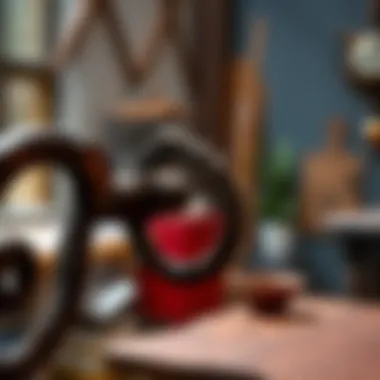
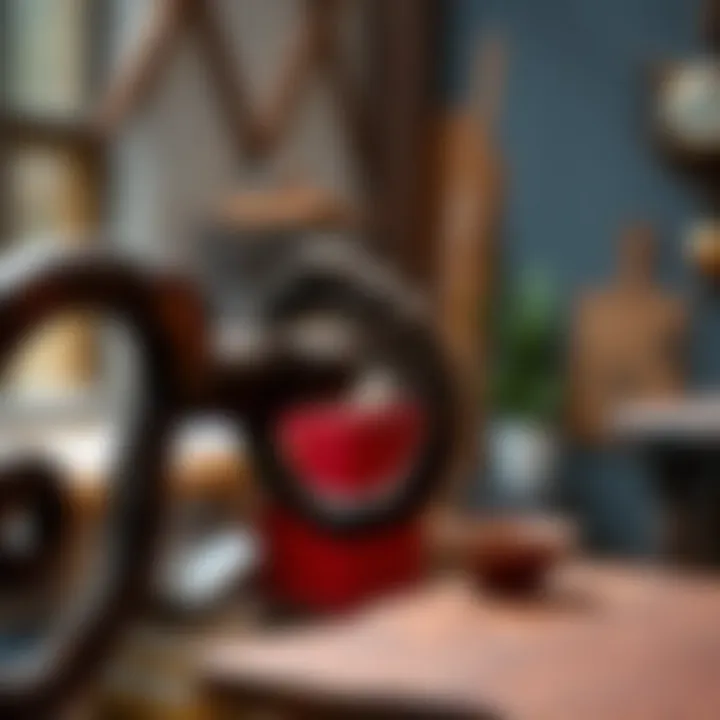
In the grand tapestry of restoring wrought iron furniture, the finishing touches hold a place of significance that shouldn’t be overlooked. This phase is where all your hard work comes together, enhancing the aesthetics while putting the final seal on the durability of your piece. The beauty of wrought iron is often in its intricate designs and textures; thus, the finishes you choose can dramatically alter the overall impression of the furniture.
One fundamental aspect of the finishing process is sealing. This isn't just about adding a topcoat but forming a protective layer that keeps elements at bay. A quality seal can ward off rust, prevent moisture accumulation, and help maintain the distinctive color and shine you’ve painstakingly applied. Plus, it acts as an added insurance policy against the everyday wear and tear that can plague indoor and outdoor pieces alike.
Sealing the Finish
When you're reaching the pinnacle of your wrought iron restoration project, sealing the finish becomes paramount. It prevents exposure to variables that can lead to deterioration, like humidity or rain when the piece is placed outdoors. There are various options for sealants available, including clear enamels and oil-based sealers that provide excellent mulch against the ravages of time.
Your choice of sealant can also influence the finish’s sheen. A glossy finish exudes elegance, while a matte one offers a more understated charm. Considering the surrounding decor and use of the furniture can help you determine the right finish.
Final Inspection
Now that the surface is finished and sealed, it’s time to give your work a thorough final inspection. This isn’t merely a formality; it's a crucial step that can be the difference between a safe, stable piece or one that's not ready for use. There are two core elements involved in this inspection: assessing stability and checking aesthetics.
Assessing Stability
Assessing stability is essential to ensure that the furniture will hold up over time. It's all about checking the joints, the sturdiness of the legs, and the overall weight distribution of the piece. You want to ensure it doesn’t wobble or give when pressure is applied. A stable piece not only guarantees safety but also longevity; it'll stand the test of time, proudly showcasing your efforts for years to come.
The key characteristic of stability in wrought iron furniture restoration is its structural integrity. Before you call your project complete, you want to make absolutely sure that everything is secure and solid. One unique feature to look for is any audible creaking when weight is applied. If you hear anything out of the ordinary, it’s a sign that further adjustments may be needed. Stability is a beneficial pursuit as it directly influences the usability of your piece, ensuring it serves its purpose perfectly.
Checking Aesthetics
Checking aesthetics is equally important. This is all about making sure your piece not only looks good but aligns with your initial vision. Take a step back, literally and figuratively, to gauge how well the colors, textures, and overall design complement the space. Are there spots where the paint hasn’t applied evenly? Has the sealant left a shiny glare in certain areas?
The beauty of aesthetics lies in its subjective nature. While some folks might prefer a vintage look that shows a hint of patina, others might desire a fresh, vibrant finish. Understanding these preferences lets you tailor the final product. Each flaw can tell a story, so balance between imperfections and an overall polished look is paramount. Ultimately, beautiful décor harmonizes the space and enhances its appeal.
"A careful eye in the final inspection phase turns a good restoration into a great one, marrying functionality with visual enjoyment."
These finishing touches may seem minor, but they play a critical role in how your restored wrought iron furniture integrates into your life. With the right care and attention to detail, you're ensuring not just a beautiful addition to your home but a piece that remains functional and durable.
Maintaining Wrought Iron Furniture
Maintaining wrought iron furniture is not just a matter of keeping it looking good; it plays a vital role in preserving its durability and functionality. Well-maintained items can last for decades, if not longer, providing both aesthetic value and practical use in various settings. Whether it’s a set of patio chairs or a decorative garden trellis, the importance of proper upkeep cannot be understated. This section will delve into the specific elements of routine care, the benefits it brings, and other considerations to keep your wrought iron pieces in excellent condition.
Routine Care Practices
Regular maintenance practices serve as the foundation for extending the lifespan of wrought iron furniture. Here are some key routines to integrate into your care schedule:
- Regular Cleaning: Dust, dirt, and debris not only accumulate and detract from the appearance but can also lead to rust formation. Use a damp cloth to wipe surfaces, followed by a thorough drying with a soft, absorbent towel. For tougher stains, a mild soapy solution can work wonders.
- Inspect for Rust: Check for any emerging rust spots, especially in joints and crevices where moisture often lingers. Prompt action can prevent the spread of rust, making it easier to manage with appropriate rust removal techniques.
- Check Stability: Give your furniture a gentle shake to assess stability. Loose joints or wobbly parts often signal the need for immediate attention. Tightening bolts or screws can be a straightforward fix to enhance structural integrity.
Incorporate these habits into your routine to maintain the beauty and function of your wrought iron treasures, ensuring they serve you well for many seasons.
Seasonal Maintenance Tips
Different seasons present unique challenges for wrought iron furniture. Here are some tips to address those seasonal factors and keep your items in optimal shape:
- Spring Prepping: After winter, perform a comprehensive inspection. Look for any ice damage or rust that could’ve formed due to freezing temperatures. A fresh coat of protective paint may be necessary to counteract any damage.
- Summer Care: The heat and sun exposure can fade colors and cause wear on furniture. Consider relocating pieces under shaded areas or using protective covers when not in use to minimize direct sunlight.
- Fall Prep: As leaves fall, they can accumulate on surfaces and retain moisture. Ensure that any debris is regularly cleared to prevent mildew or rust formation from trapped moisture.
- Winter Maintenance: The cold months can be harsh. Store smaller items indoors where possible, or use weatherproofing agents to help protect against snow and ice.
Incorporating these seasonal tips not only prolongs the life of your wrought iron furniture but keeps it looking its best throughout the year. A little preventative care goes a long way in preserving the charm and functionality of these timeless pieces.
Remember: "An ounce of prevention is worth a pound of cure." Regular attention can make all the difference.
Sustainability in Repairing Furniture
Eco-Friendly Materials
When it comes to repairing wrought iron furniture, selecting eco-friendly materials is paramount. Opting for sustainable choices reduces one's carbon footprint and aligns perfectly with the ethos of both design and environmental care. Here are a few materials worth considering:
- Non-toxic Paints: Many paints contain harmful chemicals. Discovering brands that provide low-VOC or water-based options not only makes for a safer environment but also minimizes air pollution.
- Natural Sealants: Rather than using traditional sealants that often include toxic substances, try natural alternatives like beeswax or linseed oil. They’re less harmful to your health and the earth.
- Biodegradable Cleaning Products: During the restoration process, cleaning is essential. Using eco-friendly cleaning agents helps prevent the leaching of toxic substances into the ecosystem.
Embracing these materials, while perhaps initially more difficult to source, pays off in the long run by ensuring the durability of the repairs and keeping the environment in mind.
Repurposing Old Pieces
Repurposing old wrought iron furniture isn’t just a cost-effective approach; it serves as a creative avenue to make unique design statements. Many people don't realize the potential of their old pieces, often overlooking the beauty that outdated furniture can bring back to life. Here’s how to get started:
- Inspiration Gathering: Explore design platforms like Pinterest or Houzz to find ideas on how old pieces can be integrated into modern spaces. Sometimes a simple paint job or a change in fabric can transform a worn-out item into a stunning focal point.
- Functionality Insights: Before discarding a piece due to its current function, contemplate its potential. Could an old bench serve as a coffee table with just a few modifications? The options are limitless.
- Hybrid Creations: Why not combine different pieces? Take an old wrought iron chair and merge it with a wooden bench to create a unique garden seat. The contrast between materials can add interest and appeal.
This creative approach not only breathes new life into outdated items but also allows homeowners to tell a personal story through their decor. By engaging in repurposing, you contribute not only to sustainability but also to the narrative of your living space.
"Restoring wrought iron furniture doesn’t just revive its functionality; it tells a story of preservation, creativity, and respect for our planet."
End
The act of restoring wrought iron furniture is not merely a task to bring back its original appearance. It embodies a commitment to sustainability and appreciation of craftsmanship that has withstood the test of time. Every scratch, every rust mark tells a story, and to revitalize such pieces effectively can mean preserving history. By following thorough repair techniques, individuals can enhance the aesthetic allure of their furniture while also ensuring its durability for years to come.
The Value of Restoration
Restoration is an art—a blend of creativity and practicality. When you choose to undertake the restoration of wrought iron items, you are injecting new life into overlooked treasures. This process has several notable benefits:
- Preservation of Heritage: Many wrought iron pieces have historical significance; restoring them helps preserve the craftsmanship for future generations.
- Cost-Efficiency: Instead of purchasing new items that may lack character, investing time and resources into restoring a piece can be less expensive than buying new high-quality furniture.
- Customized Aesthetics: The ability to choose colors, finishes, and styles during restoration allows personalized expression, making pieces unique and reflective of individual taste.
"By revitalizing old furniture, you're not just creating a more beautiful space; you're also telling a story that deserves to be continued."
- Reduced Environmental Impact: The environmental benefits of restoration are significant. Opting to repair rather than dispose of furniture reduces waste. It’s an eco-friendly approach, aligning personal style with global responsibility.
In summary, the importance of restoration is multi-faceted. It not only enhances visual appeal and extends the life cycle of wrought iron furniture, but also advances an eco-conscious mindset that recognizes the value in older materials. For homeowners and design enthusiasts alike, this endeavor can meld style with conviction— a unique confluence of necessity and artistry that is crucial in today's world.
For further reading on sustainability efforts, you can explore this article. To gain insights into crafting furniture for a greener tomorrow, visit British Eco Furniture and consider sharing your journey on social platforms like Facebook.
Ultimately, the value of restoration lies in more than just the finished product; it’s about the transformative experience it offers. So, whether you’re a homeowner seeking to rejuvenate your outdoor space or an interior design enthusiast, tap into the rich potential of wrought iron restoration and watch as your efforts weave history into the fabric of modern living.



